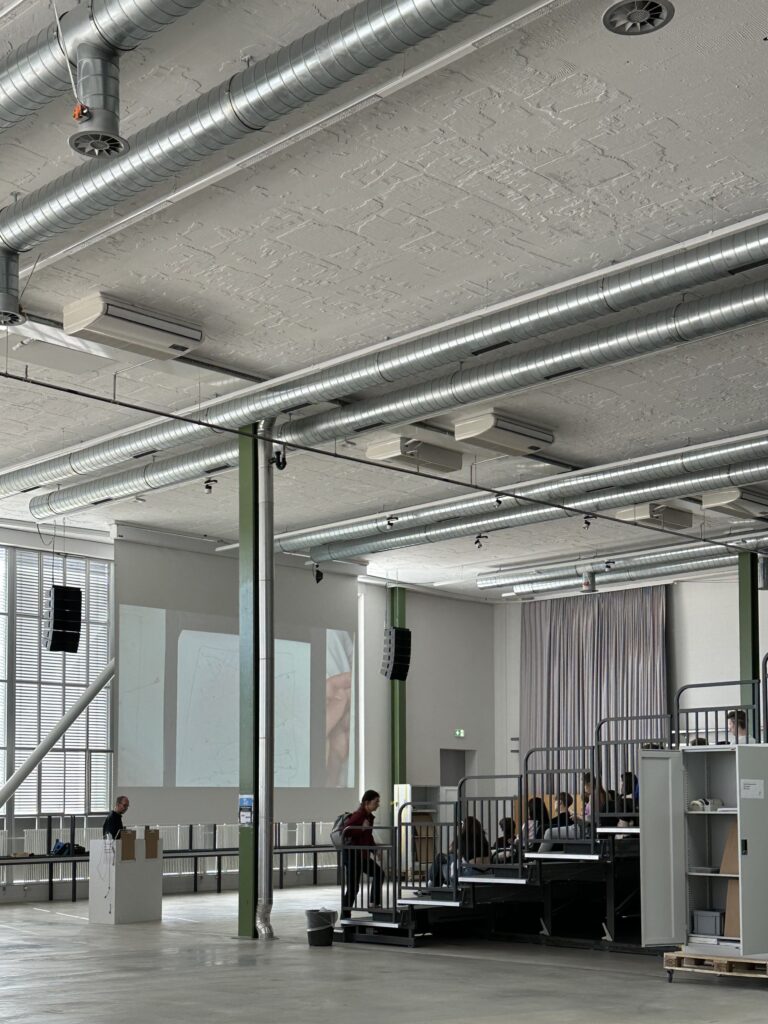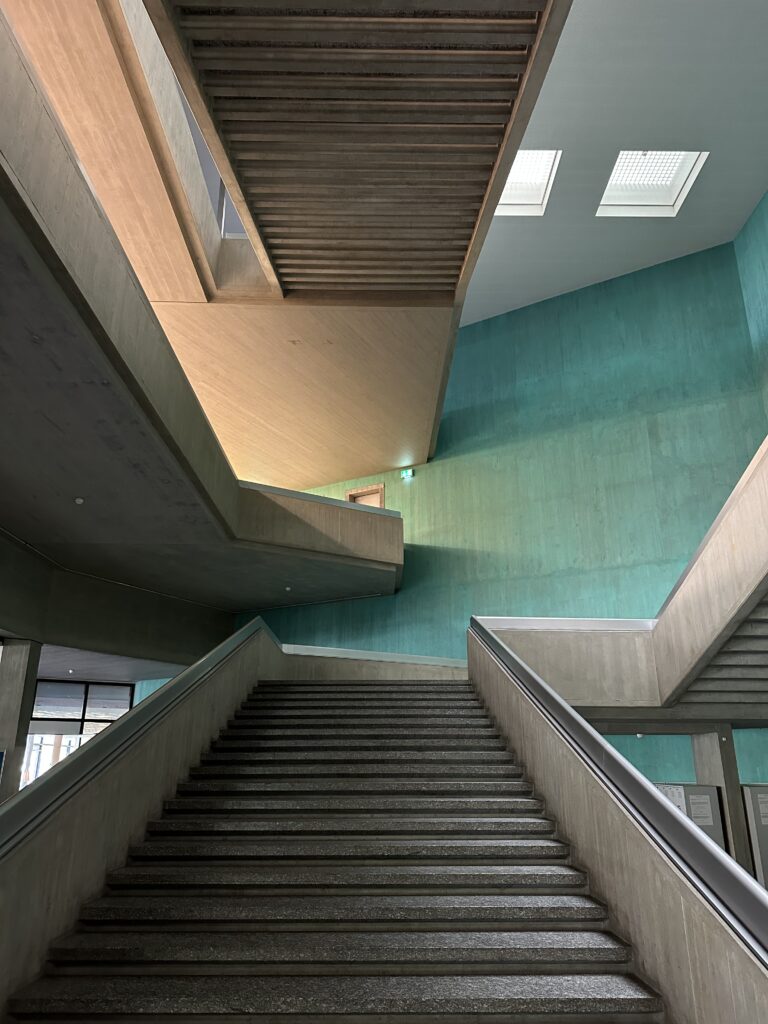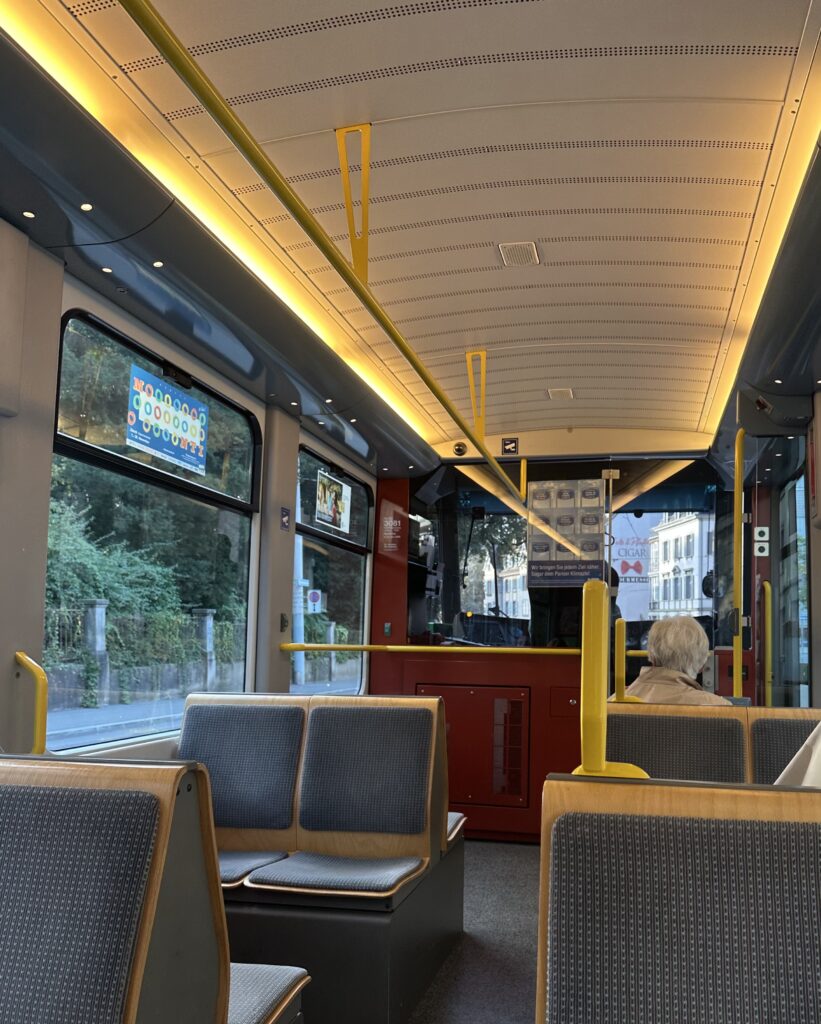01 Exploring Sound Qualities in Architectural Design
Space 1: Fokushalle (ONA E7)

Given its transformation from a former factory space into a lecture hall, there seems to be a lack of acoustics treatments.
The spacious lecture hall is constructed of concrete walls, floor, metal structures, and glazings that contribute to the longer reverberation time of the sound. These reflective elements made the sound of the lecturer linger and bounce around the room, resulting in an unclear and echoing sound. There is also an uneven sound distribution due to the sound decay in large spaces. Further noise issue comes from the exposed services above, making it more difficult for the audience to understand the spoken words without microphones or speakers.
Unlike the auditoriums, this space has limited materials that are sound-absorbing or insulating. The curtains in the hall are often open to allow daylight in. They could be closed as a temporary solution to help absorb the sound. The reflective surfaces should be controlled for better acoustic design.
Associated words: Echoey, Reverb-y
Space 2: Staircase at HPH

The sounds around the staircase echos and lingers due to the large open spaces connecting the stair. Though not distinct, it features a sense of grandeur and spaciousness. The timber cladding of the ceiling and stairs can be a sound reflector, absorber or diffuser. In this space, the timber seems to be amplifying and reflecting the sound waves together with the concrete wall.
The angled walls of the stair might also contribute to the acoustic quality. The echos were not so prominent as the non-parallel walls prevents flutter echo.
Associated words: Muddy, Discreet
Space 3: Dome (Vitra Campus)

The dome-shaped tensile tent structure is one of the most acoustically interesting spaces that I have encountered. Initially, the dome was designed for accommodating army troops, wounded or refugees. However, the actual uses vary from car showroom to exhibition event space throughout the years.
The acoustic quality inside is unique. The curved surfaces activated the longer reverberation times and bounced off the surface, resulting in obvious echos within the space. The echo can be heard clearly and vibrantly. The shape of the dome and the spacious interior space naturally amplify sound to a certain degree. Though the space has a fascinating auditory experience, I am questioning the intended use of the dome being the exhibition and event space. The excessive echos will be disruptive for most events and the acoustic quality does not seem to be aligned with the intended use.
Associated words: Echoey, Reverb-y, Amplifying
02 Exploring the Emotional Impact of Everyday Sounds
Scenerio 1: My room
When we hear sounds, the experience can feel more immediate and personal. When we see without hearing, it feels as though we are just observing the situation from afar. Sound can be immersive and evoke emotions, memories, or a feeling.
“The sense of sight implies exteriority, but sound creates an experience of interiority.”
Juhani Pallasmaa – The Eyes Of The Skin
Sitting at the desk in my room, I could hear the peaceful chirping of birds resting in the trees. Occasional presence of vehicles through my windows adjacent to the street can be heard as well. Though not completely peaceful, the occasional passing of the cars maintains a steady and rhythmic presence without being intrusive or overpowering. They remind me of the outside world without disrupting the room’s peaceful atmosphere. This allows me to disregard the sound as the background noise.
However, when I am already in a bad mood, the roar of the engine worsens my frustration. It changes from being a mere background noise into an irritating soundtrack. Volume, frequency, and the time of the day also have different impacts. Loud motor sounds in the dark peaceful hour would cause total annoyance.
Scenerio 2: Streets and tram
Every city has its own sound and echos that shape the distinct characteristics of its urban landscape. Coming here from Melbourne, I noticed the absence of the familiar ‘doop doop’ sound of the crossing signal. The ingenious sound that is mainly designed for the visually impaired, is even used to create Billie Eilish’s Bad Guy.
The lack of this familiar sound creates a void in the urban landscape, reminding me of being in a different place and situation. Crossing the street feels unfamiliar and alarming.
Similarly, the trams also have the same effect. The announcement made in German when approaching every stops felt new and, people around me conversing felt unfamiliar. In the enclosed tram, I could still grasp the familiar sound of the tram tracks, the engine and cars passing by.


03 Empirical and numerical estimation of room acoustic properties
Task 1


28 dB decay in 0.25 seconds RT60 = 0.50 sec
Task 2

04 Characterization of room acoustic treatments




